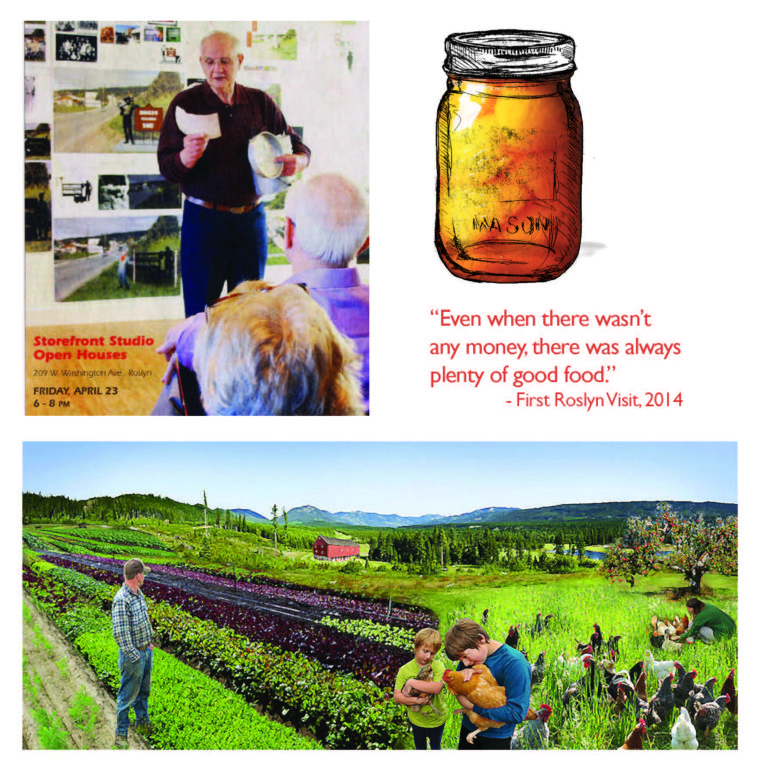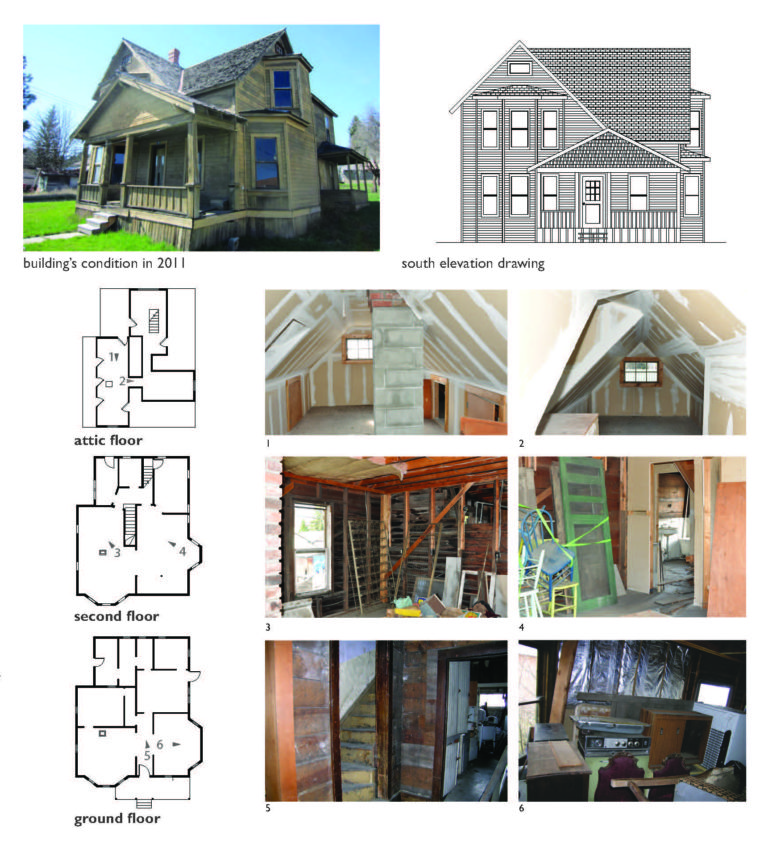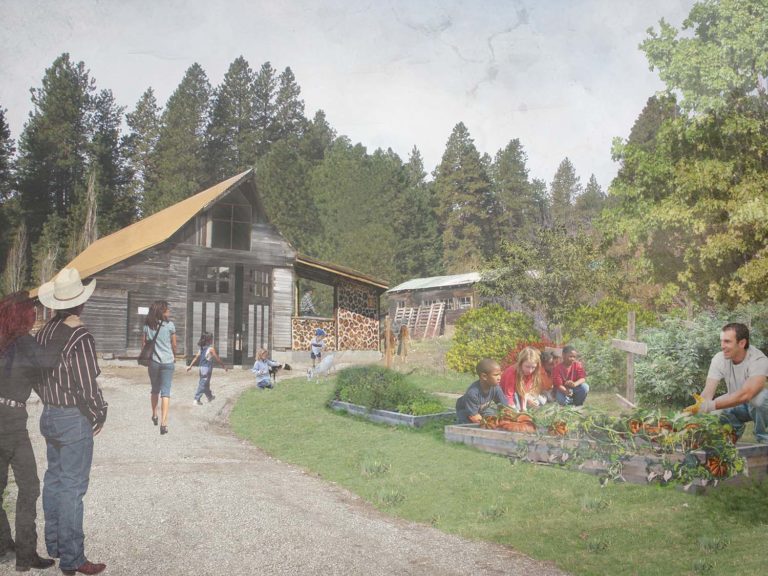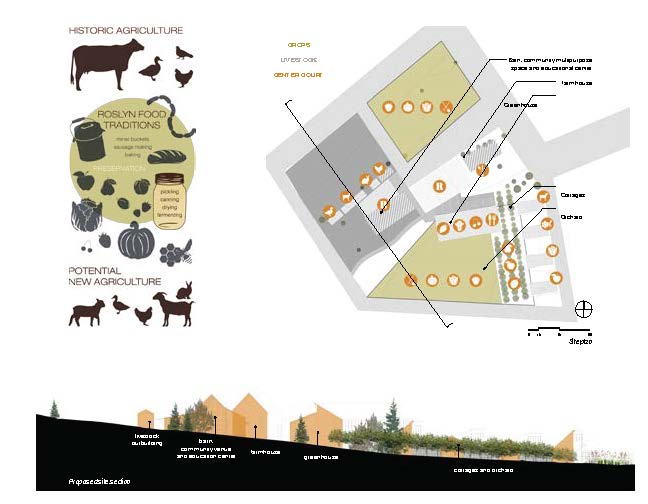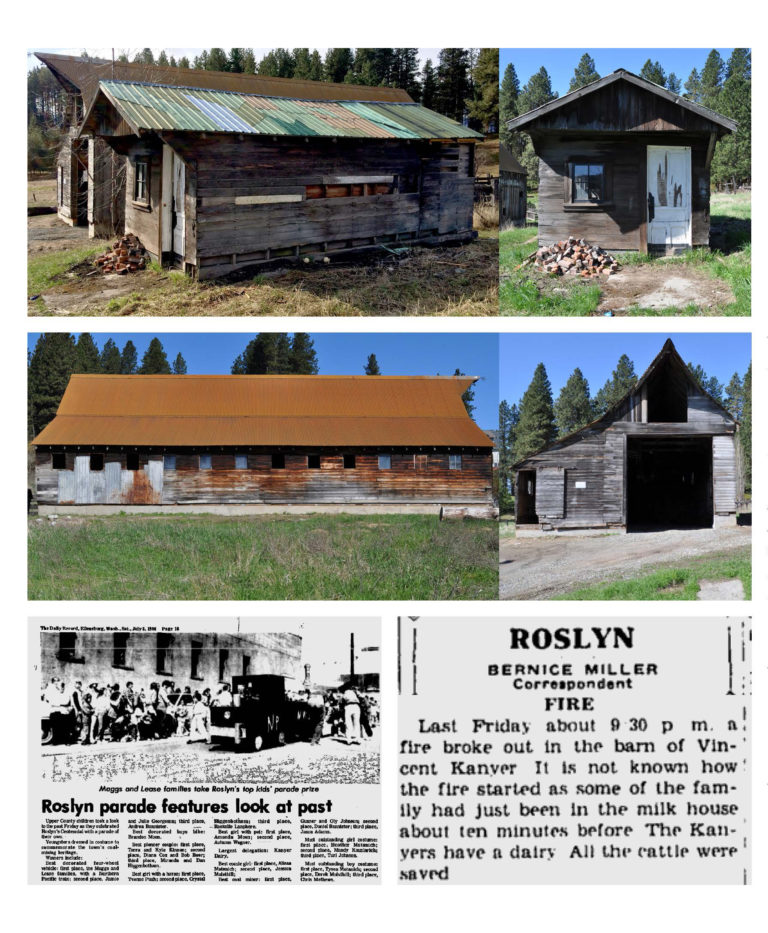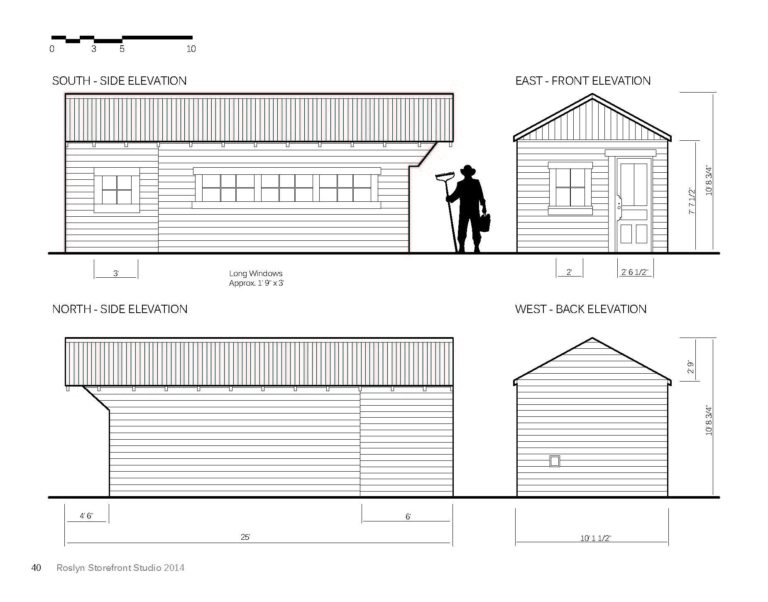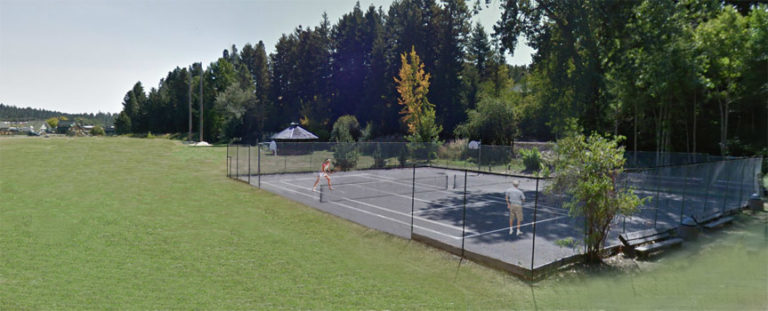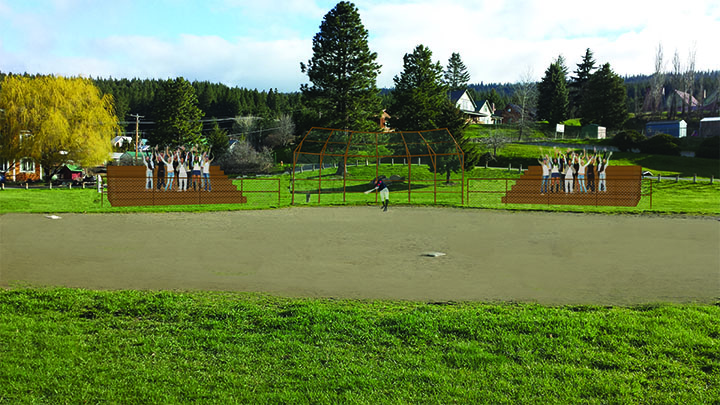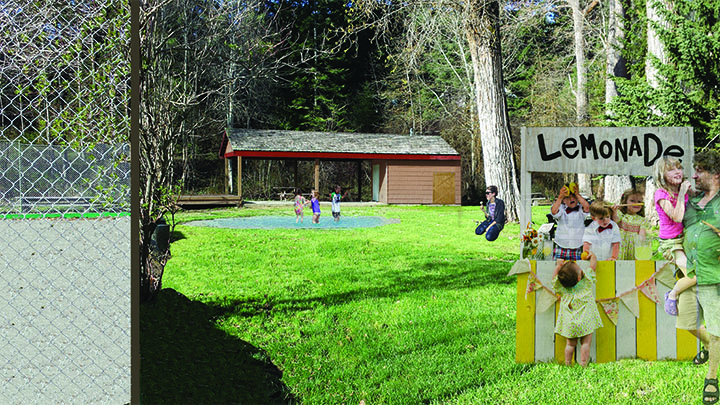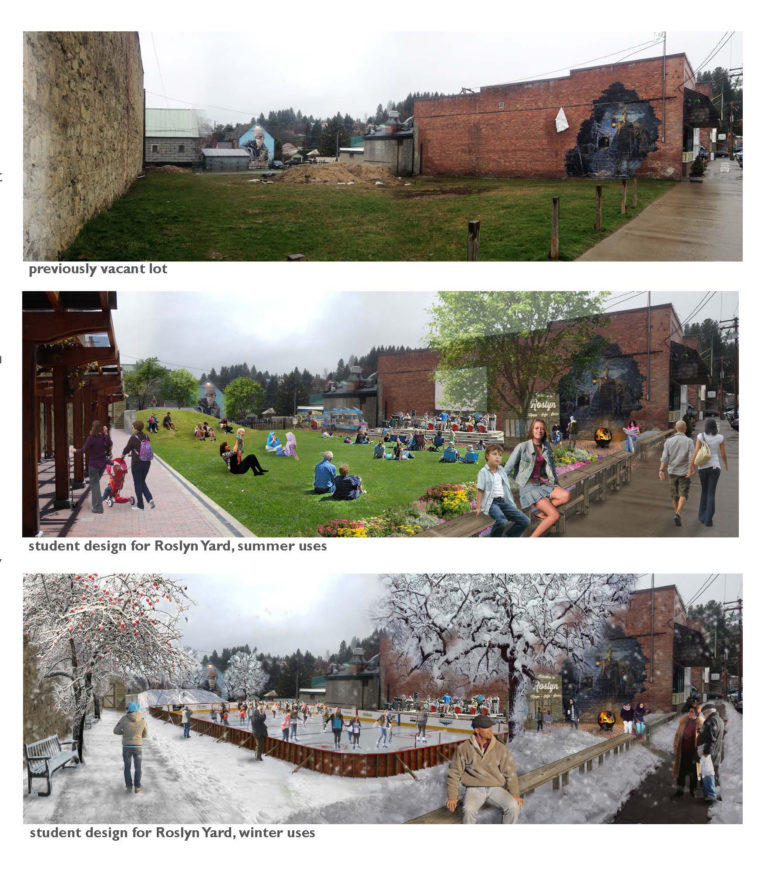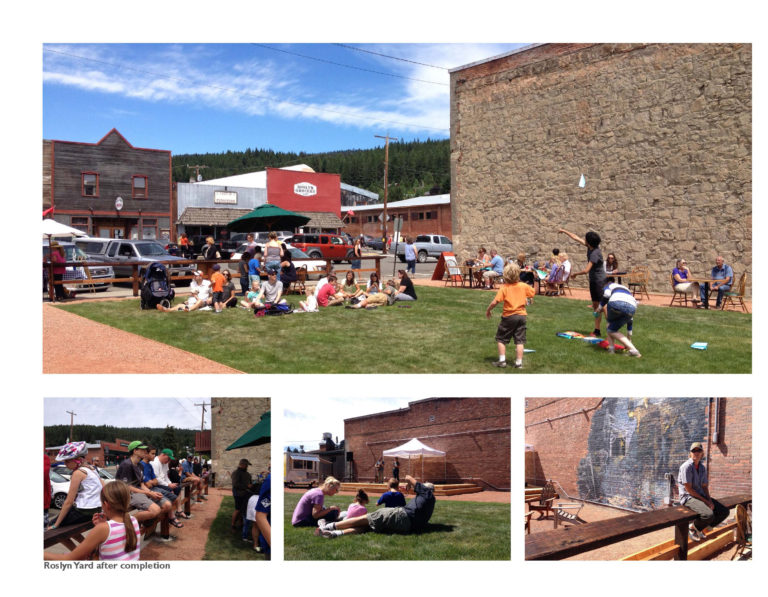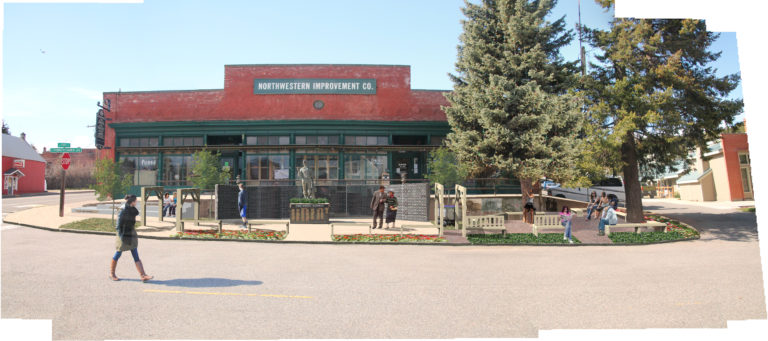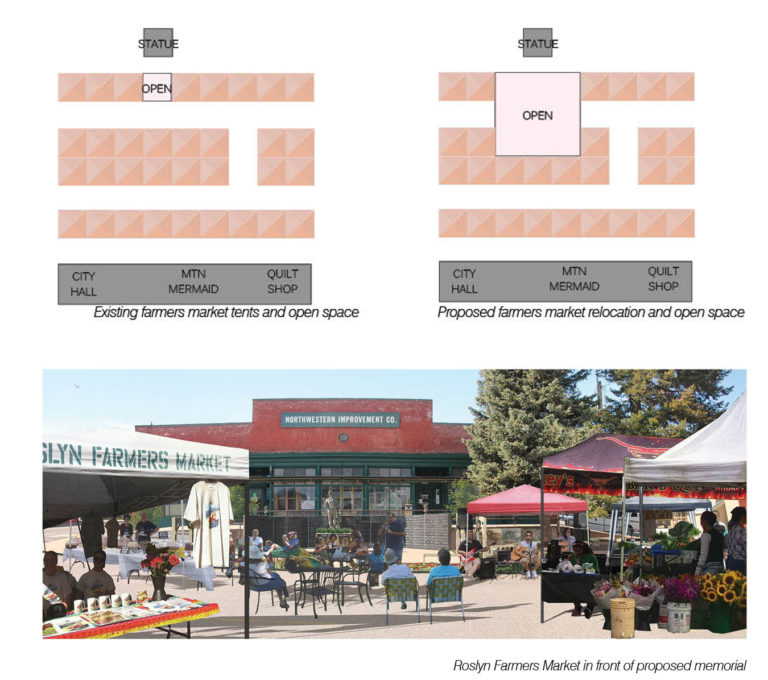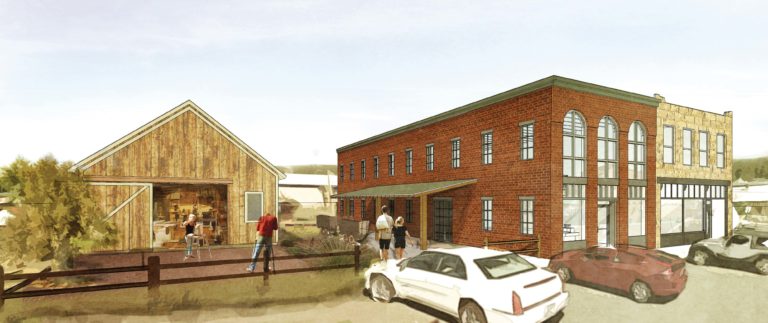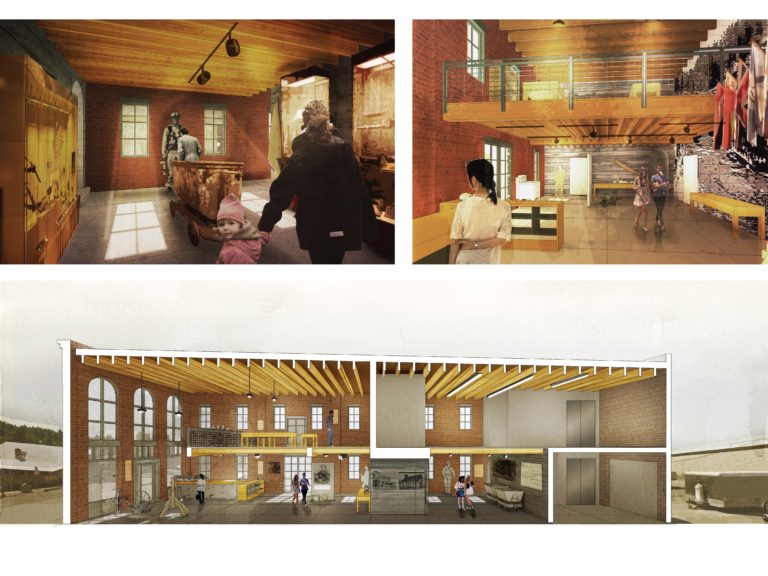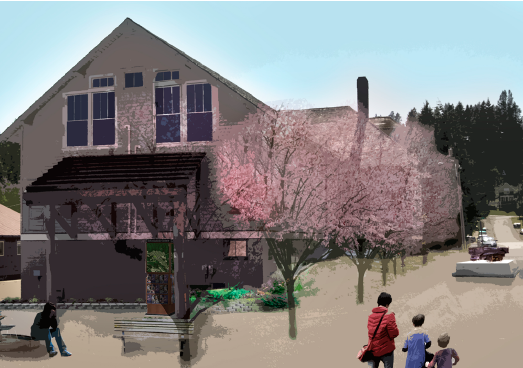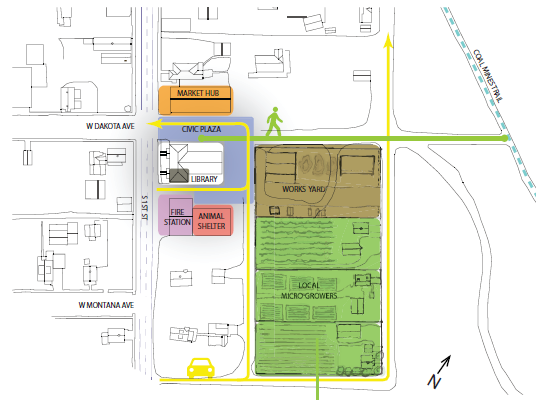This spring marks Storefront Studio’s fourth creative collaboration with the Roslyn community. This year, with help from the community, the studio outlined a few key themes that became the basis for all of the projects. These themes included tourists and locals; women of the Coal Town; Learning the Community; Storylines; Local Food and the Miner’s Bucket; Community Connections; and Food Hub Thinking.
 (1/19) At the kick-off event, we heard from several members of the community about the unique history, character and potential of Roslyn. One long-time resident of Roslyn described how coal miners would bring their lunch and drinking water into the mines in a bucket. This pioneer, do-it-yourself, homegrown history paired well with locavore food production and healthy eating. The Studio went on to study the role of food, proposing a community kitchen and ways to recharge local food production, preservation and education.
(1/19) At the kick-off event, we heard from several members of the community about the unique history, character and potential of Roslyn. One long-time resident of Roslyn described how coal miners would bring their lunch and drinking water into the mines in a bucket. This pioneer, do-it-yourself, homegrown history paired well with locavore food production and healthy eating. The Studio went on to study the role of food, proposing a community kitchen and ways to recharge local food production, preservation and education. Roslyn’s cold winters are ideal for preserving summer’s produce, and strong traditions of canning, drying, and pickling are woven throughout Roslyn’s history. A commercial incubator in Roslyn would facilitate these preservation practices and encourage culinary innovation. This year, students built on the 2011 Studio's work on the Postmasters House, proposing a community kitchen.
Roslyn’s cold winters are ideal for preserving summer’s produce, and strong traditions of canning, drying, and pickling are woven throughout Roslyn’s history. A commercial incubator in Roslyn would facilitate these preservation practices and encourage culinary innovation. This year, students built on the 2011 Studio's work on the Postmasters House, proposing a community kitchen. This community and commercial culinary incubator would allow start-up companies and gastronomic entrepreneurs to make small artisan batches in a commercially-certified kitchen.
This community and commercial culinary incubator would allow start-up companies and gastronomic entrepreneurs to make small artisan batches in a commercially-certified kitchen. The former Kanyer Dairy site is ripe with opportunity for community-supported agriculture. This project seeks to reunite Roslyn with its agricultural roots and use community food traditions to foster profitable agricultural development.
The former Kanyer Dairy site is ripe with opportunity for community-supported agriculture. This project seeks to reunite Roslyn with its agricultural roots and use community food traditions to foster profitable agricultural development. Using existing buildings and open areas, the Kanyer Dairy project also proposes new introductions to the site, including a greenhouse for horticulture and inter-generational learning, an addition to the existing barn for an interpretive, educational and assembly space, and compact cottages for farm worker housing.
Using existing buildings and open areas, the Kanyer Dairy project also proposes new introductions to the site, including a greenhouse for horticulture and inter-generational learning, an addition to the existing barn for an interpretive, educational and assembly space, and compact cottages for farm worker housing. The Kanyer Dairy Barn and nearby Creamery are farm structures built in a rural style that is slowly being lost throughout Washington State. Either through environmental erosion, fire, or lack of maintenance, many barns are being lost without proper documentation. As a group, we documented the Barn and Creamery through photographs and measured drawings to preserve its historic character. The small creamery was used for milk processing and storage and still contains equipment from when the dairy was functioning. We were guided by the HABS principles for documentation of historic buildings.
The Kanyer Dairy Barn and nearby Creamery are farm structures built in a rural style that is slowly being lost throughout Washington State. Either through environmental erosion, fire, or lack of maintenance, many barns are being lost without proper documentation. As a group, we documented the Barn and Creamery through photographs and measured drawings to preserve its historic character. The small creamery was used for milk processing and storage and still contains equipment from when the dairy was functioning. We were guided by the HABS principles for documentation of historic buildings. As a group, we documented the Barn and Creamery through photographs and measured drawings to preserve its historic character. The small creamery was used for milk processing and storage and still contains equipment from when the dairy was functioning. We were guided by the HABS principles for documentation of historic buildings.
As a group, we documented the Barn and Creamery through photographs and measured drawings to preserve its historic character. The small creamery was used for milk processing and storage and still contains equipment from when the dairy was functioning. We were guided by the HABS principles for documentation of historic buildings. The new layout of Pioneer Park would create three areas of community interaction. These include a new baseball field, a community picnic area, and an activities area.
The new layout of Pioneer Park would create three areas of community interaction. These include a new baseball field, a community picnic area, and an activities area. Pioneer Park has great baseball history, a pastime that brought the community together and provided entertainment for all. This proposal restores a baseball park that contains the elements of a historic field, expressing the history of its past glory days.
Pioneer Park has great baseball history, a pastime that brought the community together and provided entertainment for all. This proposal restores a baseball park that contains the elements of a historic field, expressing the history of its past glory days. A plaza space near the tennis court will provide an excellent location for town picnics, watching baseball games, or just enjoying the sunshine after a fun round of tennis. The new layout of Pioneer Park would create three areas of community interaction. These include a new baseball field, a community picnic area, and an activities area.
A plaza space near the tennis court will provide an excellent location for town picnics, watching baseball games, or just enjoying the sunshine after a fun round of tennis. The new layout of Pioneer Park would create three areas of community interaction. These include a new baseball field, a community picnic area, and an activities area. The vacant lot between the historic Brick Tavern and the Pioneer Restaurant offers a unique opportunity for vibrant, flexible community gathering space in the heart of downtown Roslyn. Proposed interventions include a large flat lawn, a small grassy berm, and a community stage. These are welcoming places for social interaction, play areas for children, and performance spaces for members of the local community. Crabapple, plum and other fruit trees provide a harvestable crop and create an inviting public space that all can enjoy.
The vacant lot between the historic Brick Tavern and the Pioneer Restaurant offers a unique opportunity for vibrant, flexible community gathering space in the heart of downtown Roslyn. Proposed interventions include a large flat lawn, a small grassy berm, and a community stage. These are welcoming places for social interaction, play areas for children, and performance spaces for members of the local community. Crabapple, plum and other fruit trees provide a harvestable crop and create an inviting public space that all can enjoy. In mid-May 2014, work began on a new park at the Brick Yard site, inspired by these designs.The project was completed in mid-July 2014 by local contractors and woodworkers. The park opened during the weekend of July 19-20, during Roslyn’s First Annual Art Festival.The first summer saw free concerts, food trucks and lemonade stands.
In mid-May 2014, work began on a new park at the Brick Yard site, inspired by these designs.The project was completed in mid-July 2014 by local contractors and woodworkers. The park opened during the weekend of July 19-20, during Roslyn’s First Annual Art Festival.The first summer saw free concerts, food trucks and lemonade stands. Currently, Roslyn’s coal miner’s memorial has unclear relationships with its surroundings, lacks the respect that it deserves and isn’t able to fully function as the communal space for remembrance that it should. This proposal strives to define the edge of the memorial and make it an even stronger landmark for the town by means of public interaction and natural beauty while respecting local history.
Currently, Roslyn’s coal miner’s memorial has unclear relationships with its surroundings, lacks the respect that it deserves and isn’t able to fully function as the communal space for remembrance that it should. This proposal strives to define the edge of the memorial and make it an even stronger landmark for the town by means of public interaction and natural beauty while respecting local history. This proposal redefines the relationship between the memorial and the market as a positive one that respects the reflection space yet provides a welcoming and relaxing area for community engagement. We are proposing that the market adjust the current plan (right) to accommodate more space in front of the memorial and garden for extra seating and tables (left).
This proposal redefines the relationship between the memorial and the market as a positive one that respects the reflection space yet provides a welcoming and relaxing area for community engagement. We are proposing that the market adjust the current plan (right) to accommodate more space in front of the memorial and garden for extra seating and tables (left). This project addresses the Roslyn Museum’s need for more space to display its large collection of historic artifacts and rethinks its role within the community.
This project addresses the Roslyn Museum’s need for more space to display its large collection of historic artifacts and rethinks its role within the community. By adding a hands on workshop space which incorporates historic tools and skills the new Roslyn museum not only preserves history but makes it an active part of life in Roslyn.
By adding a hands on workshop space which incorporates historic tools and skills the new Roslyn museum not only preserves history but makes it an active part of life in Roslyn. Roslyn’s City Hall has a history of community life and activity. We propose a civic campus around the City Hall site.
Roslyn’s City Hall has a history of community life and activity. We propose a civic campus around the City Hall site. A new civic campus could house the Roslyn Farmer’s Market, provide a hub for local growers, provide a new connection to the Coal Miners Trail and strengthen the site’s present with its past.
A new civic campus could house the Roslyn Farmer’s Market, provide a hub for local growers, provide a new connection to the Coal Miners Trail and strengthen the site’s present with its past. A Little Library is a unique box of books that a family or community group builds and puts on their property to share with the whole neighborhood. In Roslyn we propose creating a network of these miniature libraries that all link back to Roslyn’s main library. They would be adopted by an individual or community group and help to bring out the stories of Roslyn that make the town rich in history and authenticity. At the end of the quarter, the students built and installed a little library at the Jensen Cabin site.
A Little Library is a unique box of books that a family or community group builds and puts on their property to share with the whole neighborhood. In Roslyn we propose creating a network of these miniature libraries that all link back to Roslyn’s main library. They would be adopted by an individual or community group and help to bring out the stories of Roslyn that make the town rich in history and authenticity. At the end of the quarter, the students built and installed a little library at the Jensen Cabin site.
